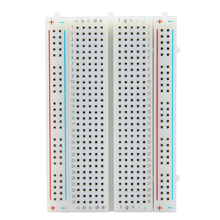In the previous article I was describing how to output number into this LED display:
But it is much interesting to display multiple numbers on a single LED module (for example: temperature and moisture or distance and time). It is pretty simple to write it in C.
Like in a previous example DIN, CS and CLK are connected with arduino through these pins: 7, 6 and 5. Here is the working prototype:
In this example are implemented two counters: 2-digits, and 5-digits. The first counter increments from 0 to 99, and then resets on reaching the maximum values. The second - reduces from 99999 to 0, and resets after the zero. In each cycle a digital display shows both numbers at the same time, with an empty place as a separator between them.
Code sample:
#include <LedControl.h>
const int DIN_PIN = 7;
const int CS_PIN = 6;
const int CLK_PIN = 5;
LedControl display = LedControl(DIN_PIN, CLK_PIN, CS_PIN);
void setup() {
display.clearDisplay(0);
display.shutdown(0, false);
display.setIntensity(0, 10);
}
void displayString(const char *chars8) {
display.clearDisplay(0);
for (int i = 0; i < 8 && chars8[i] != 0; i++) {
display.setChar(0, 7 - i, chars8[i], false);
}
}
int counter1 = 0;
long counter2 = 99999;
char chars[9] = {};
void loop() {
snprintf(chars, 9, "%-2d %5ld", counter1, counter2);
displayString(chars);
counter1++;
counter2--;
if (counter1 > 99) {
counter1 = 0;
}
if (counter2 < 0) {
counter2 = 99999;
}
delay(250);
}
In this example two numbers are packed into the char array and then displayed via the displayString() function.
I use snprintf() function for this; it is much safe then sprintf().
The first number is aligned on the left edge of the display, the second - on the right.
This code requires LedControl library.
Set of components used in this example:




